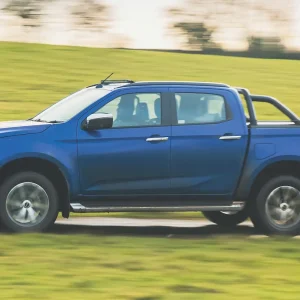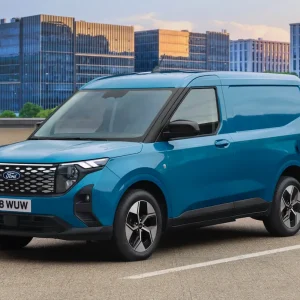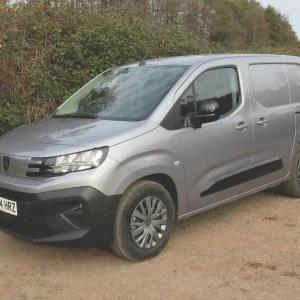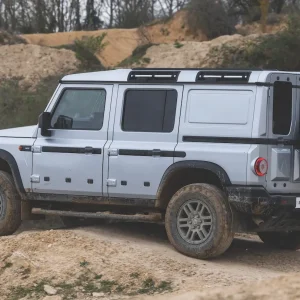When details of the new Renault Kangoo were released in March this year it felt like we were getting a raw deal when it came to some of the new headline-grabbing features. The side column to my main article on Renault’s product plans was entitled ‘The door of deception’ and I described the Renault Motor Show launch event as a “no-show”. However, having now driven the all-new Renault Kangoo it would not be unfair for me to be served some humble pie on the next Renault press event, such is the remarkable improvement of this new small van.
The vehicle tested was a European spec model, with the Open Sesame ‘door of deception’ that UK customers will not be able to have, but the fundamentals of the new Kangoo did leave a lasting impression.
To recap, the Kangoo will once again be available in two body lengths when it goes on sale in 2022.
UK specifications won’t be pinned down until later this year but there are, in theory, two petrol and three diesel engines on offer. The reasons for the delayed launch (the new Kangoo has just gone on sale in Europe) is that the UK will also have a pure electric model available at launch – the Kangoo E-Tech, which replaces the Kangoo Z.E name – and will likely have Business and Business+ trim levels as well as an Ecoleader model, which will combine fuel saving systems like a 68mph speed limiter with an Eco-Mode to help cut fuel consumption by as much as 12%.
The diesel engine will be a 1.5-litre Blue dCi unit available with outputs of 75hp, 95hp and 115hp, while the 1.3-litre TCE petrol engine will come with 100hp or 130hp. A six-speed manual gearbox will be standard but selected models will have the option of a seven-speed dual clutch transmission.
The Kangoo has undergone a significant redesign, bringing it into line with the Renault family of passenger cars, and now has a very distinctive grille and headlight design with C-shaped LED daytime running lights. It’s also changed shape slightly, resulting in not only a larger rear loadspace but also a significantly larger cabin, which is one of the elements that marks this new Kangoo out as something of a surprising contender for a shot at being called the best van in its class.
The standard van’s loadspace is 3.3m3 and the long wheelbase version has a 4.2m3 capacity. Those are the figures for a van with a solid bulkhead, but one thing that has been confirmed is that UK customers will also be able to specify their vehicles with a swivelling bulkhead and fold down passenger seat that increases the standard van’s capacity to 3.9m3 and the long version to 4.9m3. Most importantly, that will mean lengths of more than 3.0m can be transported within the van. The folding system is easy to use, well designed and quick to do and, while it does nothing more than the folding bulkhead and seat systems offered by rivals like Peugeot and Citroen, it adds a new feature to the Kangoo that the previous generation lacked.

At this point it is worth addressing the elephant in the room, the Open Sesame door, which aside from having a stupid name (it doesn’t open with a magic wand or even automatically) could possibly fit an elephant through its opening. It’s a wonderfully smart solution to a problem most people have long ago got used to living with – large items go in through the back doors, right? – but creates a good deal of versatility for loading and unloading in a busy street. The lack of a B-pillar combined with the swivel bulkhead and flat seat creates an opening so big (1,446mm) you could load items up to nearly 3.0m in length if you got creative with your approach angles. Aided by a passenger door that now opens up to 90º it gets an A* for access, but an F when it comes to availability on our right-hand drive models. One thing UK vans will definitely get, though, is the Easy Inside Rack, an interior roof rack that can hold lengths of up to 2,500mm – a great solution for keeping items off the floor of the van.
Payloads for standard vans will be around 600kg but an increased payload option will see that jump to 800kg – presumably via revised rear springs and different GVW plating – while the long wheelbase van will have a payload of around 1,000kg.
That’s the specification, but what’s the van itself like? Well, the interior is definitely the area that has improved the most. That’s largely due to the increase in size that has made the Kangoo noticeably wider in the areas that are most important – namely at your knees and elbows. As a result, the cabin feels roomier and a lot less cramped. It also looks smarter with better plastics and an 8in Easy Link touchscreen infotainment system (that supports Apple CarPlay and Android Auto), which is more seamlessly integrated into the dash. Then there’s the buttons and dials, which have been taken from the Renault Clio, not to mention wireless phone charging and handsfree card access, which automatically locks when you get out of range of the van. The seats have been improved with new material that Renault says is more hard-wearing, but they’re also more comfortable for longer journeys.
Big improvements all round then, and that’s before we get to the mechanical bits. We drove the middle-of-the-range Blue dCi 95 option, which with 94hp is a 5hp increase over the equivalent outgoing mid-range model. The new engine is certainly quieter than the old model and feels more refined too. That’s aided by extra sound deadening that has better insulated the cabin from engine and road noise, making the Kangoo much more refined than the previous model and on a par with the Ford Transit Connect and Volkswagen Caddy.
Our left-hand drive test vehicle wasn’t ideally suited to the UK’s roads and it made the ride less appealing as we bounced along the gutter, but it did show a vast improvement in ride quality. Its slight softness compared with rivals showed the new Kangoo to be comfortable and pleasant to drive. It definitely bodes well for a part or fully laden ride, and on first impressions the Kangoo is right among the best vans in the class for comfort and close in terms of driving performance, with nicely weighted steering and smooth power delivery.
While the Kangoo had done without safety features such as active emergency braking before, its 12 new driving aids help bring it in line with the competition and is now also available with blind spot monitoring and adaptive cruise control, among others.
There’s also the option of a permanent rear-view camera where the rear-view mirror would ordinarily be. It is of such high quality it’s almost distracting; when someone pulled up close behind us in traffic, we swore we could see something stuck in their teeth.
The lasting impression left by the new Kangoo is not, then, one of bitter resentment at the things we won’t get (we haven’t even mentioned the massive Easy Life glove box drawer that is also unavailable in the UK) but is instead one of great optimism for the finished article arriving next year and its potential to upset the compact van apple cart.
Renault Trafic Passenger

Unlike the Kangoo, which is getting a complete overhaul, changes to the next Renault Trafic won’t be quite so dramatic when it arrives next year.
A quick drive in the updated passenger van, however, revealed that the changes that will be made will enhance what is already in my mind a very decent all-rounder of a van.
Like the Kangoo, the next Trafic will have passenger car interior components like the 8in infotainment screen and “piano keyboard” switches underneath.There will also be vast improvements to internal storage (up to 86 litres with a bench seat) as well, and if you’re willing to spend the money as many as eight all-new driver assistance systems to choose from and 17 systems in total. Black out the windows, and the van will look the same as this passenger version – no bad thing as the new chunky grille fits the Trafic far better than the Kangoo to my untrained eye – and there’s even talk (finally) of a fully electric version coming next year too.
George Barrow is the UK judge for the International Van of the Year, the prestigious prize awarded by leading European LCV journalists
Sponsored by:






